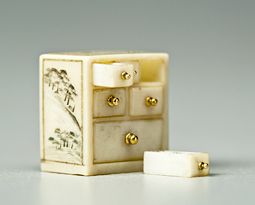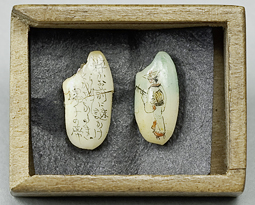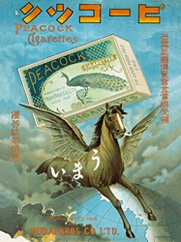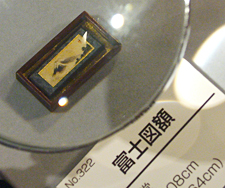 |
|
Here and There introduces art, artists, galleries and museums around Japan that non-Japanese readers and first-time visitors may find of particular interest. The writer claims no art expertise, just a subjective viewpoint acquired over many years' residence in Japan.
|
|
 |
|
|
 |
 |
Art in the Palm of Your Hand: Rekisai Kobayashi's Miniatures
Alan Gleason |
 |
 |
|
 |
Ivory chest of drawers, 0.85 x 0.54 x 0.84 cm; all the drawers open and contain such items as tiny gourds, dice, and spinning tops. By Rekisai Kobayashi and Bokkoku Asano.
|
|
Calligraphy and a painting on two grains of rice, each 6.6 x 3.5 mm (artist unknown; case by Rekisai Kobayashi). |
The Tobacco & Salt Museum owes its curious name to the fact that these two disparate substances were, until quite recently, produced and sold by the Japanese government. In the early 1900s the country's tobacco and salt industries were taken over by the Ministry of Finance. Only in 1985 were the industries re-privatized, with the postwar Japan Tobacco and Salt Public Corporation replaced by Japan Tobacco, Inc. (JT), which is still 50 percent government-owned. One of the legacies of the government monopoly is this handsome four-story museum, opened in 1978 and now run by JT.
Located in bustling Shibuya, Tokyo, the museum will tell you all you ever wanted to know about smoking and salting in Japan, and then some. After all, salt has been harvested from the sea here since the Stone Age, and tobacco entered the country not long after it had spread to Europe from the New World. As a pastime, smoking has been just as popular and tenacious in Japan as in the West. Even if you find tobacco a turnoff, the museum's determination to showcase the historical and artistic byproducts of the habit from every angle imaginable does open some serendipitous windows into Japanese culture.
A case in point is the current exhibition (closing on February 27), Kobayashi Rekisai: Art in the Palm of Your Hand -- works of miniature taken to the extreme. The word "miniatures" does not come close to doing justice to the mind-boggling works on display. Case after case is filled with miniscule, yet flawlessly faithful, copies of every conceivable item -- furniture, books, scrolls, screens, tea ceremony utensils -- and of course, tobacco pipes and pouches that look identical to those in the collection downstairs, except that they are a mere fraction the size.
The bulk of this collection is the work of one man, Rekisai Kobayashi (1884-1959), and his associates. The son of a cabinetmaker and ivory artisan, Rekisai mastered those crafts at a young age and soon began to receive orders for tobacco pouches, netsuke toggles and other paraphernalia whose connoisseurs demanded ornamentation of the highest caliber. Rekisai himself grew increasingly obsessed with reproducing all manner of everyday objects in the smallest yet most realistic form possible. His reproductions not only resemble the original objects, they work like them: drawers open, wheels turn, and calligraphy is legible -- but only under a magnifying glass. A perfectionist and stickler for detail, Rekisai often commissioned specialists to handle the painting or lacquerwork required to make these tiny masterpieces truly authentic.
 |
|
 |
| Life-size mockup of an Edo-era tobacconist: the wife cleans and presses the tobacco leaves while the husband shreds them to a fine, hair-like consistency. |
|
Poster for Peacock cigarettes, ca. 1903; the advertisements and packages of these pre-monopoly private brands were works of art in themselves. |
As Western customs came into vogue and cigarettes superseded the elegant kiseru pipe and the decorative tobacco pouch, Rekisai devoted more of his time to miniatures. In this he was egged on by one patron in particular, Minoru Nakata, a shipping company executive and patron of the arts who came up with requests for ever smaller and more elaborate objects to challenge Rekisai's skills. The artist, for his part, was more than happy to rise to the challenge.
Since smoking accessories were a significant part of Rekisai's oeuvre, it makes sense that the Tobacco & Salt Museum would acquire a collection of his work. The tobacco bureau of the Finance Ministry had begun collecting smoking-related art and artifacts back in the early 1930s, making the museum a natural candidate for the Nakata family's vast trove of miniatures.
The Rekisai exhibition alone is reason enough to visit the museum, but while you're at it, do check out the floors devoted to salt and tobacco. Yes, there are rather predictable paeans to the virtues of the tobacco plant and photos of "famous tobacco lovers in Japanese history," but there are also a number of displays that are fascinating in their own right -- everything from a colorful collection of smoking pipes from around the world to an impressive diorama depicting how vast stretches of Japan's coastline were once devoted to salt production.
Even if the museum's appointed mission seems to be to sing the praises of the history and culture of smoking, non-smokers need not fear: smoking in the museum is confined to one of those claustrophobic glass rooms one sees in airport terminals and other public buildings. Or maybe that's one of the exhibits too.
 |
|
 |
Painting of Mt. Fuji, viewed through a magnifying glass, 0.86 x 2.08 cm; the label provides an idea of its actual size. By Ritsudo Kobayashi.
|
|
Ivory storage case, 2.6 x 3.4 x 0.7 cm; it contains a doll whose limbs move, a shamisen bridge, tops that spin, a purse with netsuke attached, and a seal case that comes apart. By Rekisai Kobayashi, Bokkoku Asano and Minoru Nakata.
All images courtesy of the Tobacco & Salt Museum
|
|
|
|
|
|
 |
Kobayashi Rekisai: Art in the Palm of Your Hand |
 |
20 November 2010 - 27 February 2011 |
 |
Tobacco & Salt Museum |
 |
Jinnan 1-16-8, Shibuya-ku, Tokyo
Phone: 03-3476-2041
Hours: 10:00 - 18:00 (admission until 17:30) (closed Monday, or the following Tuesday when Monday is a national holiday, and 29 December - 3 January)
Transportation: 10-minute walk from the Hachiko exit of JR Shibuya station |
 |
|
 |
|
|
 |
 |
Alan Gleason
Alan Gleason is a translator, editor and writer based in Tokyo, where he has lived for 25 years. In addition to writing about the Japanese art scene he has edited and translated works on Japanese theater (from kabuki to the avant-garde) and music (both traditional and contemporary). |
|
|
|
 |
|